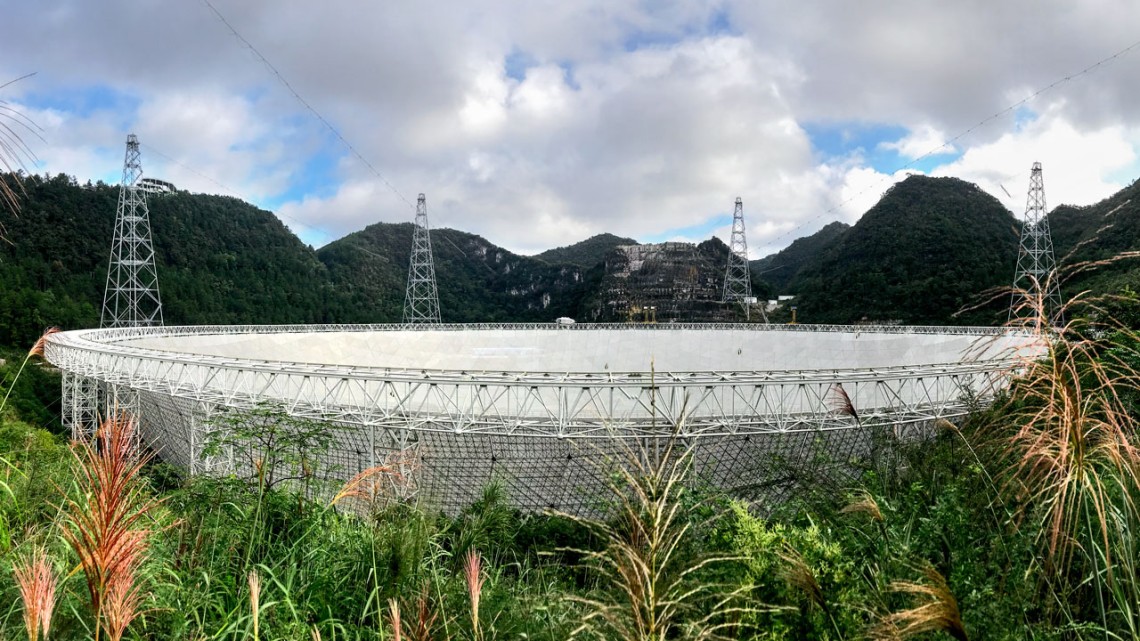
The 500-meter Aperture Spherical radio Telescope, known as FAST, in Ghizou province, southwest China, where Fast Radio Burst 20190520B was discovered, is considered the spiritual successor to the now-defunct, Cornell-built Arecibo Observatory in Puerto Rico.
Rapid-fire fast radio burst shows hot space between galaxies
By Blaine Friedlander, Cornell Chronicle
A rare and persistent rapid-fire fast radio burst source – sending out an occasional and informative cosmic ping from more than 3.5 billion light years away – now helps to reveal the secrets of the broiling hot space between the galaxies.
What excites astronomers about the repeating fast radio bursts (FRBs) – since they only burst once, generally speaking – is that these quick-fire surges provide a pathway for scientists to comprehend the perplexing, mysterious and million-degree intergalactic medium.
This work, “A Repeating Fast Radio Burst Associated with a Persistent Radio Source,” was published June 8 in Nature, by an international group of scientists led by Chinese and Cornell astronomers.
“Examining the intergalactic medium is really hard,” said co-author Shami Chatterjee, Ph.D. ’03, principal research scientist in astronomy in the College of Arts and Sciences. “The intergalactic medium is difficult to probe, which is why fast radio bursts are exciting. The bursts let us study the properties of the intergalactic medium.”
Joining Chatterjee on the Nature paper are James M. Cordes, the George Feldstein Professor of Astronomy (A&S) and Stella K. Ocker, a doctoral student in astronomy.
Co-author Di Li, Ph.D. ’02, is the chief scientist of both FAST and the radio division of the National Astronomical Observatories of Chinese Academy of Sciences. The observatory has discovered more than 100 pulsars and more than 5 FRBs.
Fast Radio Burst 20190520B – an incredibly prolific repeating burst source – was first observed in June 2019 by the Five-hundred-meter Aperture Spherical radio Telescope (FAST), in Ghizou province, southwest China. Astronomers generally consider this telescope as the spiritual successor to the now-defunct, Cornell-built Arecibo Observatory in Puerto Rico.
After FAST found the burst, scientists then pinpointed the burst’s location using the Very Large Array, Socorro, New Mexico.
Four bursts were detected during the initial 24-second scan in 2019, according to the paper. Between April and September 2020, during follow-up observations, FAST detected 75.
Due to the rapidly repeating bursts, astronomers believe that FRB 20190520B may be quite young. “It seems to reside in a complex plasma environment, like that expected in a young supernova remnant,” Chatterjee said. “So one possibility is that the highly active source may be a newborn, and if so, it paints an intriguing evolutionary picture of FRB sources, where young burst sources are associated with persistent radio emission.
“The persistent emission fades away as the burst repetition rate slows down,” Chatterjee said. “This is still very much a hypothesis and we are eager to test it with further examples of repeating FRBs.”
Astronomers usually assume that FRBs pass through only a modest amount of gas (free electrons) in their host galaxies, which makes counting electrons in the intergalactic medium an easier task. FRB 20190520B shows the opposite: It has encountered far more gas in its host galaxy than scientists expected, calling into question previous assumptions.
Ultimately, astronomers want to know how the intergalactic medium is formed.
“We want to deconstruct how many free electrons are in the intergalactic medium, because it has been extremely difficult to study,” Ocker said. “We don’t know much about it.”
“This particular new repeating FRB behaves in extreme, surprising ways,” Ocker said. “The surrounding environment is extraordinarily complex and dynamic, which offering us critical clues to FRBs’ mysterious origins. FRB 20190520B emphasizes the importance of identifying and characterizing the host galaxies of FRBs before we can use them as probes of the intergalactic medium.”
Other recent Cornell papers related to this research include: “The Large Dispersion and Scattering of FRB 20190520B are Dominated by the Host Galaxy,” which was led by Ocker. The astronomers assessed implications of the large dispersion measure (examining the very short FRB signal) to understand the host galaxy.
The second paper, “Redshift Estimation and Constraints on Intergalactic and Interstellar Media from Dispersion and Scattering of Fast Radio Bursts,” led by Cordes, estimated dispersion measure contributions from host galaxies.
Both papers appear May 27 in the Astrophysical Journal. Funding for this research was provided by the National Science Foundation.
Media Contact
Get Cornell news delivered right to your inbox.
Subscribe
